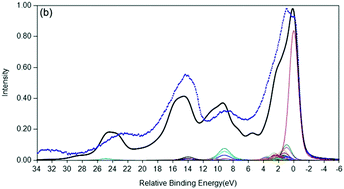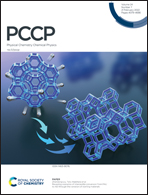Origin of the complex main and satellite features in Fe 2p XPS of Fe2O3†
Abstract
Although the origin and assignment of the complex XPS features of the cations in ionic compounds has been the subject of extensive theoretical work, agreement with experimental observations remains insufficient for unambiguous interpretation. This paper presents a rigorous ab initio treatment of the main and satellite features in the Fe 2p XPS of Fe2O3. This has been possible using a unique methodology for the selection of orbitals that are used to form the ionic wavefunctions. This orbital selection makes it possible to treat both the angular momentum coupling of the open shell core and valence electrons as well the shake excitations from the closed shell orbitals associated with the O ligands into the valence open shell orbitals associated with the Fe 3d shell. This allows the character of the ionic states in terms of the occupations of the open shell core and valence orbitals and of the contributions of 2p1/2 and 2p3/2 ionization to the XPS intensities to be determined. Our analysis gives strong evidence that many body effects are essential for a correct description of the ionic states and, in general the states cannot be described by a single configuration over the open shell orbitals. An important consequence is that the Fe 2p XPS intensity in most of the features arises from small contributions from the ionization to many, tens to hundreds, of often unresolved ionic states. While the usual understanding of the lower binding energy main and satellite features as being dominantly from 2p3/2 ionization is confirmed, this is not the case for the higher binding energy features where 2p1/2 and 2p3/2 ionization and shake excitations in the valence space mix strongly. Furthermore, we have been able to show that a very large fraction, 88%, of the total Fe 2p XPS intensity is contained in a relatively small binding energy range of ∼35 eV. This is relevant if one wants to extract the stoichiometry of Fe2O3 from Fe 2p/O 1s intensity ratios. Similar considerations about the importance of many-body effects are likely to be relevant for other ionic compounds as well.



 Please wait while we load your content...
Please wait while we load your content...